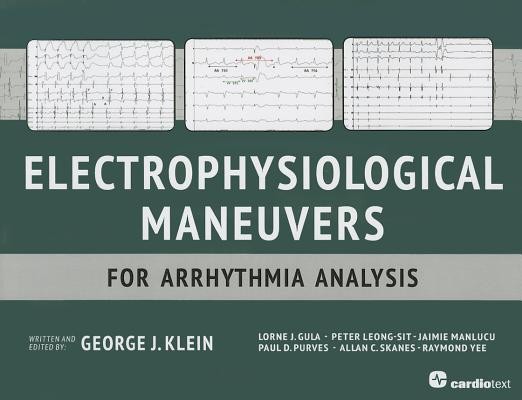
- We will send in 10–14 business days.
- Author: George J Klein
- Publisher: Cardiotext Inc
- Year: 2014
- Pages: 195
- ISBN-10: 1935395890
- ISBN-13: 9781935395898
- Format: 21.6 x 27.7 x 2.3 cm, softcover
- Language: English
- SAVE -10% with code: EXTRA
Electrophysiological Maneuvers for Arrhythmia Analysis (e-book) (used book) | bookbook.eu
Reviews
Description
- From senior electrophysiologist and world-class educator George Klein, a fully illustrated guide with over 100 intracardiac tracings and figures that allow the physician to approach electrophysiologic problems effectively and systematically.
- The book is especially focused on electrophysiological maneuvers and provides a clear and understandable guide to their proper selection and interpretation using abundant clinical examples.
- Defines the integral role for "traditional" electrogram (EGM) analysis in order to understand the mechanism of a tachycardia.
It goes without saying that a correct arrhythmia diagnosis is a prerequisite to catheter ablation regardless of the presence of sophisticated mapping and imaging technologies. Electrophysiological maneuvers are fundamental to this process, and proper selection and interpretation of maneuvers constitute a core skill of the electrophysiologist. In this volume, we make the case that most maneuvers are fundamentally similar in principle and can be understood by appreciating a few basic physiological and anatomical principles. The art lies not in a comprehensive knowledge by rote of every maneuver or its application, but rather a systematic approach using common principles. We illustrate this by showing abundant examples and emphasizing the "game plan," including checklists that can be applied to virtually any maneuver.
-George J. Klein
In my opinion, this book should be on the shelf of every electrophysiologist trainee as well as every clinical cardiac electrophysiologist. It is a classic, like its editor. Dr. Klein deserves high praise for organizing his and his colleagues' clinical experiences and thought processes into a concise, practical text that should be part of all training programs in electrophysiology.
-From the foreword by Mark E. Josephson, MD
EXTRA 10 % discount with code: EXTRA
The promotion ends in 21d.00:17:57
The discount code is valid when purchasing from 10 €. Discounts do not stack.
- Author: George J Klein
- Publisher: Cardiotext Inc
- Year: 2014
- Pages: 195
- ISBN-10: 1935395890
- ISBN-13: 9781935395898
- Format: 21.6 x 27.7 x 2.3 cm, softcover
- Language: English English
- From senior electrophysiologist and world-class educator George Klein, a fully illustrated guide with over 100 intracardiac tracings and figures that allow the physician to approach electrophysiologic problems effectively and systematically.
- The book is especially focused on electrophysiological maneuvers and provides a clear and understandable guide to their proper selection and interpretation using abundant clinical examples.
- Defines the integral role for "traditional" electrogram (EGM) analysis in order to understand the mechanism of a tachycardia.
It goes without saying that a correct arrhythmia diagnosis is a prerequisite to catheter ablation regardless of the presence of sophisticated mapping and imaging technologies. Electrophysiological maneuvers are fundamental to this process, and proper selection and interpretation of maneuvers constitute a core skill of the electrophysiologist. In this volume, we make the case that most maneuvers are fundamentally similar in principle and can be understood by appreciating a few basic physiological and anatomical principles. The art lies not in a comprehensive knowledge by rote of every maneuver or its application, but rather a systematic approach using common principles. We illustrate this by showing abundant examples and emphasizing the "game plan," including checklists that can be applied to virtually any maneuver.
-George J. Klein
In my opinion, this book should be on the shelf of every electrophysiologist trainee as well as every clinical cardiac electrophysiologist. It is a classic, like its editor. Dr. Klein deserves high praise for organizing his and his colleagues' clinical experiences and thought processes into a concise, practical text that should be part of all training programs in electrophysiology.
-From the foreword by Mark E. Josephson, MD


Reviews